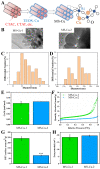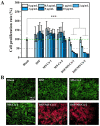An In Situ Chemotherapy Drug Combined with Immune Checkpoint Inhibitor for Chemoimmunotherapy
- PMID: 38133040
- PMCID: PMC10746032
- DOI: 10.3390/nano13243144
An In Situ Chemotherapy Drug Combined with Immune Checkpoint Inhibitor for Chemoimmunotherapy
Abstract
Clinically, cancer chemotherapy still faces unsatisfactory efficacy due to drug resistance and severe side effects, including tiredness, hair loss, feeling sick, etc. The clinical benefits of checkpoint inhibitors have revived hope for cancer immunotherapy, but the objective response rate of immune checkpoint inhibitors remains around 10-40%. Herein, two types of copper-doped mesoporous silica nanoparticles (MS-Cu-1 with a diameter of about 30 nm and MS-Cu-2 with a diameter of about 200 nm) were synthesized using a one-pot method. Both MS-Cu-1 and MS-Cu-2 nanoparticles showed excellent tumor microenvironment regulation properties with elevated extracellular and intracellular ROS generation, extracellular and intracellular oxygenation, and intracellular GSH depletion. In particular, MS-Cu-2 nanoparticles demonstrated a better microenvironment modulation effect than MS-Cu-1 nanoparticles. The DSF/MS-Cu composites with disulfiram (DSF) and copper co-delivery characteristics were prepared by a straightforward method using chloroform as the solvent. Cell survival rate and live/dead staining results showed that DSF and MS-Cu alone were not toxic to LLC cells, while a low dose of DSF/MS-Cu (1-10 μg/mL) showed a strong cell-killing effect. In addition, MS-Cu-2 nanoparticles released more Cu2+ in a weakly acidic environment (pH = 5) than in a physiological environment (pH = 7.4), and the Cu2+ released was 41.72 ± 0.96 mg/L in 1 h under weakly acidic conditions. UV-visible absorption spectrometry confirmed the production of tumor-killing drugs (CuETs). The intratumoral injection of DSF/MS-Cu significantly inhibited tumor growth in vivo by converting nontoxic DSF/MS-Cu into toxic CuETs. The combination of DSF/MS-Cu and anti-CTLA-4 antibody further inhibited tumor growth, showing the synergistic effect of DSF/MS-Cu and immune checkpoint inhibitors.
Keywords: chemoimmunotherapy; copper-dopped mesoporous silica (MS-Cu); disulfiram (DSF); nontoxic to toxic; tumor environment regulation.
Conflict of interest statement
The authors declare no conflict of interest.
Figures








Similar articles
-
In Situ Synthesis of a Tumor-Microenvironment-Responsive Chemotherapy Drug.Pharmaceutics. 2023 Apr 21;15(4):1316. doi: 10.3390/pharmaceutics15041316. Pharmaceutics. 2023. PMID: 37111800 Free PMC article.
-
Enhanced Tumor-Specific Disulfiram Chemotherapy by In Situ Cu2+ Chelation-Initiated Nontoxicity-to-Toxicity Transition.J Am Chem Soc. 2019 Jul 24;141(29):11531-11539. doi: 10.1021/jacs.9b03503. Epub 2019 Jul 15. J Am Chem Soc. 2019. PMID: 31251050
-
Glutathione-responsive copper-disulfiram nanoparticles for enhanced tumor chemotherapy.J Control Release. 2022 Jan;341:351-363. doi: 10.1016/j.jconrel.2021.11.041. Epub 2021 Nov 29. J Control Release. 2022. PMID: 34856225
-
Recent Advances in Repurposing Disulfiram and Disulfiram Derivatives as Copper-Dependent Anticancer Agents.Front Mol Biosci. 2021 Sep 17;8:741316. doi: 10.3389/fmolb.2021.741316. eCollection 2021. Front Mol Biosci. 2021. PMID: 34604310 Free PMC article. Review.
-
Old wine in new bottles: Advanced drug delivery systems for disulfiram-based cancer therapy.J Control Release. 2020 Mar 10;319:352-359. doi: 10.1016/j.jconrel.2020.01.001. Epub 2020 Jan 3. J Control Release. 2020. PMID: 31911155 Review.
Cited by
-
Copper homeostasis and copper-induced cell death in tumor immunity: implications for therapeutic strategies in cancer immunotherapy.Biomark Res. 2024 Oct 31;12(1):130. doi: 10.1186/s40364-024-00677-8. Biomark Res. 2024. PMID: 39482784 Free PMC article. Review.
References
-
- Li X., Yamazaki T., Ebara M., Shirahata N., Hanagata N. Hanagata. Nanoengineered coordination polymers boost cancer immunotherapy. Mater. Today. 2023;67:127–150.
Grants and funding
LinkOut - more resources
Full Text Sources
Research Materials

